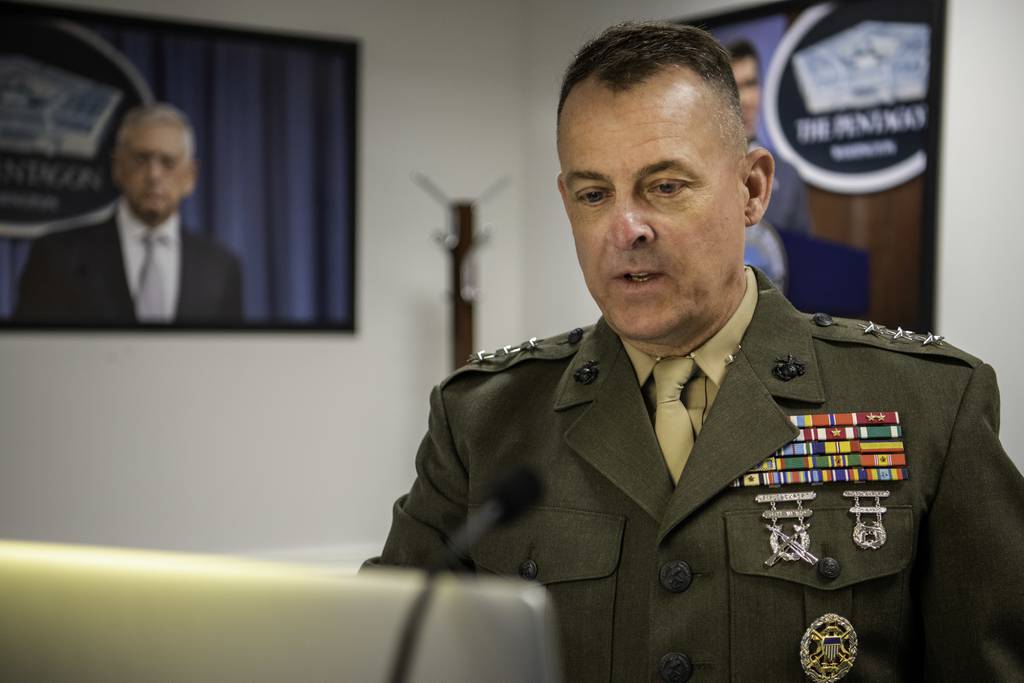WASHINGTON — A leader of the Department of Defense’s artificial intelligence efforts said discussions about the technology are less focused on futuristic death machines and more about upgrading the department and helping maintain the U.S. competitive edge.
“Inside the department, clearly there’s a question about what is AI for,” Marine Corps Lt. Gen. Michael Groen, director of the Joint Artificial Intelligence Center, said May 25 at an Atlantic Council event. “And, although there are conversations about killer robots and all the rest, I think the reality is much more mundane.”
“As we look at the ecosystem around us, the business environment, the production environment, the investment environment, all driven by artificial intelligence, it’s easy for us to see models for how we need to transform the department,” he said. “And this is what we’re after.”
The stakes are high. As the Defense Department bureaucracy and the military services consume increasing volumes of information and seek smart tools that process data in the most efficient and comprehensive way, so are adversaries.
Integrating AI in a correct, thoughtful manner can make all the difference, Groen said. The Pentagon as of April 2021 was juggling at least 685 AI projects, including a handful for major weapons systems, according to a Government Accountability Office report released this year. The full extent of the portfolio is undisclosed.
“We’ve spent a lot of time in education to help people understand that just like an automobile extends your capabilities in the physical domain, artificial intelligence extends your abilities within the data domain and the information domain,” the general said Wednesday.
AI and its traces can be found across the Pentagon and its many enclaves and alcoves. The department has for years recognized its value as well, describing the tech in a 2018 strategy as rapidly changing businesses, industries and military threats. More can be done, Groen said.
“Implementation in the department, of course, is always a challenge, as new technology meets legacy processes, legacy organizations and legacy technology,” he said, later adding: “We believe that a lot of the rules have to change, a lot of the thought processes have been rendered obsolete, and, maybe, the cores of how our organizational processes work have to be reevaluated through the lens of artificial intelligence and data.”
To better coordinate and expedite all things data, AI and analytics, the Pentagon in late 2021 announced a new suite: the chief digital and AI office, or CDAO.
The CDAO achieved initial operating capacity at the beginning of February — less than two months after it was unveiled — and is expected to be fully up and running in the near future. Craig Martell, the man once in charge of machine learning at ride-share company Lyft, was tapped to lead the digital-first office. It will subsume the JAIC, which Groen led for more than a year, as well as the Defense Digital Service, Breaking Defense reported May 24.
An inquiry made to the Defense Department by C4ISRNET on May 25 was not immediately answered.
Groen recently announced his retirement on LinkedIn, saying he is headed for the exit with “high confidence in our innovative Marines, our innovative leaders (who do not fear thoughtful change), our mission and our Corps.”
Colin Demarest was a reporter at C4ISRNET, where he covered military networks, cyber and IT. Colin had previously covered the Department of Energy and its National Nuclear Security Administration — namely Cold War cleanup and nuclear weapons development — for a daily newspaper in South Carolina. Colin is also an award-winning photographer.








